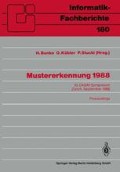Zusammenfassung
Digitale Bilder entstehen durch Abtasten der stetigen Bildebene an endlich vielen, diskreten Stellen (meist Quadratraster). Mathematisch wird der Entstehungsprozeß jedes Bildelementes (‘Pixel’) als Faltung der stetigen Bildfunktion mit der Abtastfunktion beschrieben. Dabei werden Reflexionswerte aus einer zusammenhängenden Umgebung der Meßstelle integriert. Die Abtastfunktion hat eine endliche Ausdehnung, außerhalb ist sie O. Wir definieren das rezeptive Feld eines Pixels als jene Region der Bildebene, aus der Information im Pixel gespeichert sein kann. Diese Definition soll nicht nur für das abgetastete Bild, sondern auch für die weiterverarbeiteten Bilder gelten. Ist das rezeptive Feld eines Pixels kleiner als der Abstand zwischen zwei benachbarten Pixeln, so ist die Bildinformation nur unvollständig wiedergegeben. Überlappen einander die rezeptiven Felder von benachbarten Pixeln stark, so entsteht eine redundante Bilddarstellung.
Access this chapter
Tax calculation will be finalised at checkout
Purchases are for personal use only
Preview
Unable to display preview. Download preview PDF.
Literatur
E. H. Adelson, C. H. Anderson, J. R. Bergen, P. J. Burt, and J. M. Ogden. Pyramid methods in image processing. RCA Engineer, Vol. 29–6, Nov./Dec. 1984.
R. P. Blanford and S. L. Tanimoto. Bright-spot detection in pyramids. In Proc. Eighth International Conference on Pattern Recognition, pages 1280–1282, IEEE Comp.Soc, Paris, Prance, October 1986.
P. J. Burt and E. H. Adelson. The Laplacian pyramid as a compact image code. IEEE Transactions on Communications, Vol. COM-31(No.4):pp.532–540, April 1983.
P. J. Burt, C. H. Anderson, J. O. Sinniger, and G. van der Wal. A pipelined pyramid machine. In S. Levialdi and V. Cantoni, editors, Pyramidal Systems for Image Processing and Computer Vision, pages 133–152, Springer-Verlag Berlin, Heidelberg, 1986.
J. L. Crowley and A. Parker. A representation of shape based on peaks and ridges in the difference of low-pass transform. IEEE Trans. Pattern Analysis and Machine Intelligence, PAMI-6:pp.156–170, 1984.
J. L. Crowley and R. M. Stern. Fast computation of the difference of low-pass transform. IEEE Transactions on Pattern Analysis and Machine Intelligence, PAMI-6:pp.212–222, 1984.
A. D. Gross. Multiresolution Object Detection and Delineation. PhD thesis, University of Maryland, Computer Science Center, January 1986.
R. M. Haralick, C. Lin, J. S. J. Lee, and X. Zhuang. Multi-resolution morphology. In Proceedings of the First International Conference on Computer Vision, pages 516–520, London, England, June 1987.
G. Hartmann. Recognition of hierarchically encoded images by technical and biological systems. Biological Cybernetics, Vol. 57:pp.73–84, 1987.
W. G. Kropatsch. Curve representations in multiple resolutions. Pattern Recognition Letters, Vol. 6(No. 3):pp.l79–184, August 1987.
W. G. Kropatsch. Elimination von “kleinen” Kurvenstücken in der 2x2/2 Kurvenpyramide. In E. Paulus, editor, Mustererkennung 1987, pages 156–160, Springer Verlag, 1987.
W. G. Kropatsch. Grauwert und Kurvenpyramide, das ideale Paar. In G. Hartmann, editor, Mustererkennung 1986, pages 79–83, Springer Verlag, 1986.
W. G. Kropatsch. A pyramid that grows by powers of 2. Pattern Recognition Letters, Vol. 3:pp.315–322, 1985.
S. Peleg and O. Federbush. Custom made pyramids. In S. Levialdi and V. Cantoni, editors, Pyramidal Systems for Image Processing and Computer Vision, pages 165–172, Springer-Verlag Berlin, Heidelberg, 1986.
S. L. Tanimoto. Paradigms for pyramid machine algorithms. Li S. Levialdi and V. Cantoni, editors, Pyramidal Systems for Image Processing and Computer Vision, pages 173–194, Springer-Verlag Berlin, Heidelberg, 1986.
Author information
Authors and Affiliations
Editor information
Editors and Affiliations
Rights and permissions
Copyright information
© 1988 Springer-Verlag Berlin Heidelberg
About this paper
Cite this paper
Kropatsch, W.G. (1988). Rezeptive Felder in Bildpyramiden. In: Bunke, H., Kübler, O., Stucki, P. (eds) Mustererkennung 1988. Informatik-Fachberichte, vol 180. Springer, Berlin, Heidelberg. https://doi.org/10.1007/978-3-662-08895-1_46
Download citation
DOI: https://doi.org/10.1007/978-3-662-08895-1_46
Publisher Name: Springer, Berlin, Heidelberg
Print ISBN: 978-3-540-50280-7
Online ISBN: 978-3-662-08895-1
eBook Packages: Springer Book Archive

